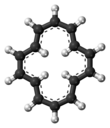Cyclotetradecaheptaene
| |||
| Names | |||
|---|---|---|---|
| IUPAC name
(1E,3Z,5E,7Z,9E,11E,13Z)-cyclotetradeca-1,3,5,7,9,11,13-heptaene
| |||
| Other names
[14]Annulene
| |||
| Identifiers | |||
3D model (JSmol)
|
|||
| ChEBI | |||
| ChemSpider | |||
PubChem CID
|
|||
CompTox Dashboard (EPA)
|
|||
| |||
| |||
| Properties | |||
| C14H14 | |||
| Molar mass | 182.266 g·mol−1 | ||
| Appearance | dark-red needle-like crytals | ||
| Insoluble | |||
| Solubility in benzene | Soluble | ||
| Structure[1] | |||
| monoclinic | |||
| P21/c, No. 14 | |||
a = 8.640 Å, b = 4.376 Å, c = 14.997 Å α = 90°, β = 106°, γ = 90°
| |||
Formula units (Z)
|
2 molecules per cell | ||
| Hazards | |||
| Occupational safety and health (OHS/OSH): | |||
Main hazards
|
Flammable, reactive | ||
Except where otherwise noted, data are given for materials in their standard state (at 25 °C [77 °F], 100 kPa).
| |||
Cyclotetradecaheptaene, often referred to as [14]annulene, is a hydrocarbon with molecular formula C14H14, which played an important role in the development of criteria (Hückel's rule) for aromaticity, a stabilizing property of central importance in physical organic chemistry. It forms dark-red needle-like crystals.[1]
Structure and aromaticity
[edit]Although the conjugated ring of [14]annulene contains 4n+2 electrons, it only exhibits limited evidence for being aromatic. It does not fully conform to Hückel's rule because none of its cis/trans isomers can adopt a completely planar conformation due to crowding of the interior hydrogens.[2] There is evidence that it has two isomeric forms of comparable stability (trans, cis, trans, cis, trans, trans, cis- with four interior hydrogens (shown in the infobox) and trans, cis, trans, cis, trans, cis, cis- with three interior hydrogens) which rapidly interconvert at room temperature but can be observed at low temperature by NMR.[3] Its 1H NMR spectrum shows evidence of aromatic ring currents that result in an upfield shift for the interior hydrogens. In contrast, the corresponding [12]- and [16]annulenes, which are weakly antiaromatic or nonaromatic, have downfield shifted interior hydrogens. However, unlike the undoubtedly aromatic [18]annulene, [14]annulene does not bear the hallmark aromatic property of chemical stability, and it quickly decomposes when exposed to light and air.[4]
References
[edit]- ^ a b Chiang, Chian C.; Paul, Iain C. (1972). "Crystal and Molecular Structure of [14]Annulene". J. Am. Chem. Soc. 94 (13): 4741–4743. doi:10.1021/ja00768a058.
- ^ G. M. Badger. Aromatic Character and Aromaticity. Cambridge University Press. p. 96.
- ^ H., Lowry, Thomas (1987). Mechanism and theory in organic chemistry. Richardson, Kathleen Schueller. (3rd ed.). New York: Harper & Row. ISBN 0060440848. OCLC 14214254.
{{cite book}}: CS1 maint: multiple names: authors list (link) - ^ Sondheimer, Franz; Gaoni, Yehiel (1960). "Unsaturated Macrocyclic Compounds. XV. Cyclotetradecaheptaene". Journal of the American Chemical Society. 82 (21): 5765–5766. doi:10.1021/ja01506a061.


